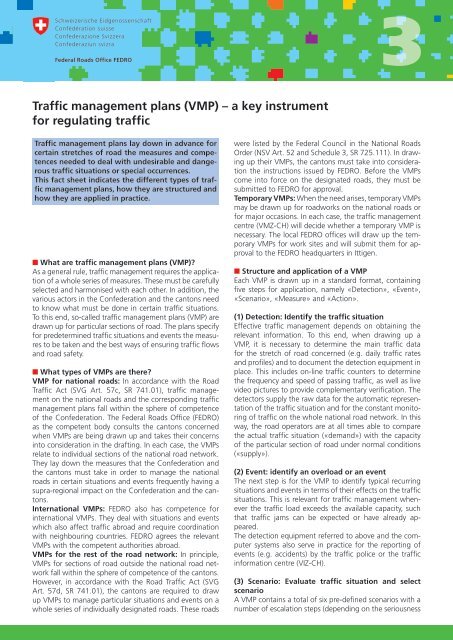Traffic management plans (VMP) – a key instrument for ... - Brintex
Traffic management plans (VMP) – a key instrument for ... - Brintex
Traffic management plans (VMP) – a key instrument for ... - Brintex
You also want an ePaper? Increase the reach of your titles
YUMPU automatically turns print PDFs into web optimized ePapers that Google loves.
Schweizerische Eidgenossenschaft<br />
Confédération suisse<br />
Confederazione Svizzera<br />
Confederaziun svizra<br />
Federal Roads Office FEDRO<br />
<strong>Traffic</strong> <strong>management</strong> <strong>plans</strong> (<strong>VMP</strong>) <strong>–</strong> a <strong>key</strong> <strong>instrument</strong><br />
<strong>for</strong> regulating traffic<br />
<strong>Traffic</strong> <strong>management</strong> <strong>plans</strong> lay down in advance <strong>for</strong><br />
certain stretches of road the measures and competences<br />
needed to deal with undesirable and dangerous<br />
traffic situations or special occurrences.<br />
This fact sheet indicates the different types of traffic<br />
<strong>management</strong> <strong>plans</strong>, how they are structured and<br />
how they are applied in practice.<br />
n What are traffic <strong>management</strong> <strong>plans</strong> (<strong>VMP</strong>)?<br />
As a general rule, traffic <strong>management</strong> requires the application<br />
of a whole series of measures. These must be carefully<br />
selected and harmonised with each other. In addition, the<br />
various actors in the Confederation and the cantons need<br />
to know what must be done in certain traffic situations.<br />
To this end, so-called traffic <strong>management</strong> <strong>plans</strong> (<strong>VMP</strong>) are<br />
drawn up <strong>for</strong> particular sections of road. The <strong>plans</strong> specify<br />
<strong>for</strong> predetermined traffic situations and events the measures<br />
to be taken and the best ways of ensuring traffic flows<br />
and road safety.<br />
n What types of <strong>VMP</strong>s are there?<br />
<strong>VMP</strong> <strong>for</strong> national roads: In accordance with the Road<br />
<strong>Traffic</strong> Act (SVG Art. 57c, SR 741.01), traffic <strong>management</strong><br />
on the national roads and the corresponding traffic<br />
<strong>management</strong> <strong>plans</strong> fall within the sphere of competence<br />
of the Confederation. The Federal Roads Office (FEDRO)<br />
as the competent body consults the cantons concerned<br />
when <strong>VMP</strong>s are being drawn up and takes their concerns<br />
into consideration in the drafting. In each case, the <strong>VMP</strong>s<br />
relate to individual sections of the national road network.<br />
They lay down the measures that the Confederation and<br />
the cantons must take in order to manage the national<br />
roads in certain situations and events frequently having a<br />
supra-regional impact on the Confederation and the cantons.<br />
International <strong>VMP</strong>s: FEDRO also has competence <strong>for</strong><br />
international <strong>VMP</strong>s. They deal with situations and events<br />
which also affect traffic abroad and require coordination<br />
with neighbouring countries. FEDRO agrees the relevant<br />
<strong>VMP</strong>s with the competent authorities abroad.<br />
<strong>VMP</strong>s <strong>for</strong> the rest of the road network: In principle,<br />
<strong>VMP</strong>s <strong>for</strong> sections of road outside the national road network<br />
fall within the sphere of competence of the cantons.<br />
However, in accordance with the Road <strong>Traffic</strong> Act (SVG<br />
Art. 57d, SR 741.01), the cantons are required to draw<br />
up <strong>VMP</strong>s to manage particular situations and events on a<br />
whole series of individually designated roads. These roads<br />
3<br />
were listed by the Federal Council in the National Roads<br />
Order (NSV Art. 52 and Schedule 3, SR 725.111). In drawing<br />
up their <strong>VMP</strong>s, the cantons must take into consideration<br />
the instructions issued by FEDRO. Be<strong>for</strong>e the <strong>VMP</strong>s<br />
come into <strong>for</strong>ce on the designated roads, they must be<br />
submitted to FEDRO <strong>for</strong> approval.<br />
Temporary <strong>VMP</strong>s: When the need arises, temporary <strong>VMP</strong>s<br />
may be drawn up <strong>for</strong> roadworks on the national roads or<br />
<strong>for</strong> major occasions. In each case, the traffic <strong>management</strong><br />
centre (VMZ-CH) will decide whether a temporary <strong>VMP</strong> is<br />
necessary. The local FEDRO offices will draw up the temporary<br />
<strong>VMP</strong>s <strong>for</strong> work sites and will submit them <strong>for</strong> approval<br />
to the FEDRO headquarters in Ittigen.<br />
n Structure and application of a <strong>VMP</strong><br />
Each <strong>VMP</strong> is drawn up in a standard <strong>for</strong>mat, containing<br />
five steps <strong>for</strong> application, namely «Detection», «Event»,<br />
«Scenario», «Measure» and «Action».<br />
(1) Detection: Identify the traffic situation<br />
Effective traffic <strong>management</strong> depends on obtaining the<br />
relevant in<strong>for</strong>mation. To this end, when drawing up a<br />
<strong>VMP</strong>, it is necessary to determine the main traffic data<br />
<strong>for</strong> the stretch of road concerned (e.g. daily traffic rates<br />
and profiles) and to document the detection equipment in<br />
place. This includes on-line traffic counters to determine<br />
the frequency and speed of passing traffic, as well as live<br />
video pictures to provide complementary verification. The<br />
detectors supply the raw data <strong>for</strong> the automatic representation<br />
of the traffic situation and <strong>for</strong> the constant monitoring<br />
of traffic on the whole national road network. In this<br />
way, the road operators are at all times able to compare<br />
the actual traffic situation («demand») with the capacity<br />
of the particular section of road under normal conditions<br />
(«supply»).<br />
(2) Event: identify an overload or an event<br />
The next step is <strong>for</strong> the <strong>VMP</strong> to identify typical recurring<br />
situations and events in terms of their effects on the traffic<br />
situations. This is relevant <strong>for</strong> traffic <strong>management</strong> whenever<br />
the traffic load exceeds the available capacity, such<br />
that traffic jams can be expected or have already appeared.<br />
The detection equipment referred to above and the computer<br />
systems also serve in practice <strong>for</strong> the reporting of<br />
events (e.g. accidents) by the traffic police or the traffic<br />
in<strong>for</strong>mation centre (VIZ-CH).<br />
(3) Scenario: Evaluate traffic situation and select<br />
scenario<br />
A <strong>VMP</strong> contains a total of six pre-defined scenarios with a<br />
number of escalation steps (depending on the seriousness
of the effects). They relate to the <strong>for</strong>ecast or actual overloads<br />
of total traffic or HGV traffic, to the reduction in the<br />
number of lanes or to road blocks<br />
Each <strong>VMP</strong> specifies the scenarios, pre-defining the<br />
threshold values, the geographical extent, the duration of<br />
the event and resulting delays. In addition, the scenarios<br />
contain possible alternative routes.<br />
When a <strong>VMP</strong> is implemented, the road operators select one<br />
of the six pre-defined scenarios, taking into consideration<br />
the actual traffic situation and the default thresholds.<br />
(4) Measures: Ordering measures to be taken<br />
For each scenario, the <strong>VMP</strong> lays down in advance the appropriate<br />
measures to be taken to deal with the particular<br />
event. The allocation of the measures depends on the<br />
duration of the event (e.g. time taken to clear the scene<br />
of an accident), the extent (e.g. the length of the traffic<br />
jam), the location of the event and possible deviation and<br />
bypass routes. <strong>Traffic</strong> <strong>management</strong> measures within the<br />
national road network can be taken by the operators at<br />
the VMZ-CH at their own initiative. If the measures will affect<br />
the cantonal traffic police and/or the subsidiary road<br />
network, the cantons concerned must be consulted to<br />
obtain their approval. If the planned measures will affect<br />
the <strong>for</strong>eign road network, prior consultation will again be<br />
needed with the <strong>for</strong>eign authorities concerned. The activation<br />
of a cantonal <strong>VMP</strong> that will impact on the flow of<br />
traffic on the national roads requires the prior approval of<br />
the VMZ-CH.<br />
(5) Action: Implement individual actions<br />
The <strong>VMP</strong> lists all of the actions needed to implement a<br />
preselected measure. In addition, the plan regulates the<br />
competences <strong>for</strong> the implementation of the actions. In<br />
a transitional phase, the traffic operators in the cantonal<br />
traffic <strong>management</strong> centres initiate the action in accordance<br />
with the measures instructed by the VMZ-CH.<br />
This includes the use of variable message signs, variable<br />
direction signs and variable traffic signals. The dissemination<br />
of the relevant traffic in<strong>for</strong>mation also proceeds on<br />
the instructions of the VMZ-CH by the staff of the national<br />
traffic in<strong>for</strong>mation centre (VIZ-CH).<br />
Quantify the traffic<br />
situation<br />
Actions to be<br />
taken and<br />
accompanying<br />
actions<br />
Activate<br />
switches<br />
Figure: Structure of a traffic <strong>management</strong> plan<br />
n What happens if there is no <strong>VMP</strong> available?<br />
<strong>VMP</strong>s are available <strong>for</strong> many events that can be <strong>for</strong>eseen<br />
and prepared <strong>for</strong>. However, not every traffic situation can<br />
be <strong>for</strong>eseen and planned <strong>for</strong>. If no <strong>VMP</strong> is available, the<br />
competent authorities take so-called «ad hoc» measures.<br />
The competences described above apply <strong>for</strong> the drawing<br />
up and implementation of such measures.<br />
n Road map <strong>for</strong> drawing up the <strong>VMP</strong><br />
The drawing up the <strong>VMP</strong> proceeded in stages. Initially,<br />
FEDRO prepared the main <strong>VMP</strong>s <strong>for</strong> the north-south and<br />
the west-east axes and agreed them with the cantons concerned.<br />
As the <strong>VMP</strong>s represent new territory <strong>for</strong> Switzerland,<br />
FEDRO and the cantons will be submitting them to<br />
a test phase with effect from the beginning of 2008. On<br />
the basis of the results of the test phase, the competent<br />
authorities will optimise and, where applicable, further<br />
develop the <strong>VMP</strong>s. There will then be a public consultation<br />
in the cantons, as required by law.<br />
In parallel, FEDRO will proceed during a second phase to<br />
draw up <strong>VMP</strong>s <strong>for</strong> the other sections of the national road<br />
network and will agree them with the competent authorities<br />
at home and abroad. At the same time, the cantons<br />
will need to draw up the <strong>VMP</strong>s stipulated by law <strong>for</strong> «the<br />
rest of the road network» (see above).<br />
However, that will not be end of the story. The <strong>VMP</strong>s will<br />
still need to be constantly revised and brought into line<br />
with the latest technical and organisational requirements.<br />
n Contact<br />
Federal Roads Office (FEDRO)<br />
CH-3003 Berne<br />
Tel: 031 322 94 11<br />
Fax: 031 323 23 03<br />
info@astra.admin.ch<br />
www.astra.admin.ch<br />
March 2008<br />
implement<br />
monitor<br />
Actions<br />
In<strong>for</strong>mation / network mgmt /<br />
branch mgmt / node mgmt as<br />
object-specific, ad hoc or <strong>VMP</strong><br />
measures<br />
www.astra.admin.ch<br />
Measures<br />
speed, numbers,<br />
HGVs, etc<br />
Detection<br />
allocate<br />
identify<br />
Event<br />
Scenario<br />
assess<br />
Initiate package of<br />
measures appropriate<br />
<strong>for</strong> the scenario<br />
Deviations from<br />
normal condition<br />
or congestion<br />
Extent in space and<br />
time, predictability<br />
Is traffic seriously<br />
affected?<br />
Check availability of alternative<br />
routes. Assess likely delays.

















